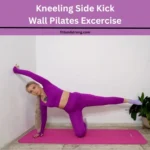When learning the fundamental mechanics of Wall Lunges, one might question where to start. With a multitude of lunging variations available, it becomes challenging to determine the best starting point and how to choose the most suitable one.
However, the optimal choice is often the one that requires minimal coaching cues while helping you to understand what’s right and what’s wrong. Using the wall as the best tool to master this movement is an excellent first strategy.
In this article, you will learn why the wall should be your go-to method to learn a lunge, break down common problems, and how the wall fixes them. It will also cover essential Safety and Precautions to avoid unwanted injuries.
If you want to do upper body wall exercises along with lower, then you must check this out:
What is Wall Lunges
Wall lunges are a dynamic exercise that combines the principles of traditional lunges with the stability and alignment benefits of a wall. This unique aspect of using the wall not only enhances lower body strength, targeting quadriceps, hamstrings, glutes, and calves, but also adds an element of resistance.
This resistance is key in maintaining posture and muscle engagement, thus reducing the risk of injury and ensuring a targeted workout. Especially beneficial for beginners or those with stability concerns, wall lunges provide support and controlled motion, crucial for learning the correct form.
As a fitness expert, I recognize wall lunges as an excellent addition to routines, focusing on a blend of strength, balance, and flexibility training for improvement in overall fitness.
I found this video to have good form and technique. If you are a beginner or a senior, avoid weights and try the wall lunges exercise freely. Increase the intensity of this exercise as you progress over a few weeks.
How to do Wall Lunges
- Start by placing your back attached to the wall for your starting position.
- Create enough space to move, ensuring comfort.
- Take a step forward with your right leg, keeping your left leg rested against the wall.
- Ensure your knee remains above your ankle to prevent strain.
- As you bend downwards, maintain an upright torso and bend your left knee until it almost touches the ground.
- Focus on the descending phase as much as the ascending phase, inhaling on the way down and exhaling on the way up.
- Return to the initial stance, aligning your metatarsals against the wall for balance and stability.
- Do 10 to 12 reps like this on the same leg, then switch to the other leg and do 2 sets of this exercise.
Wall Lunges Benefits
Enhanced Muscle Development
Wall lunges uniformly strengthen the quadriceps, hamstrings, glutes, and calves, promoting balanced muscle growth and power in the legs.
Spinal Alignment and Posture
Regular practice of this exercise helps in maintaining an upright posture and aligning the spine and pelvis, crucial for long-term spinal health.
Unilateral Training for Stability
As a unilateral training exercise, wall lunges train both sides of the body equally, enhancing stability and coordination, essential for daily activities and sports.
Safe for Beginners and Seniors
This low-impact, controlled environment makes wall lunges a safe exercise option for beginners and seniors, reducing the risk of injury.
Joint Flexibility and Strength
Especially beneficial for seniors, wall lunges help in maintaining joint flexibility and strength without putting excessive stress on the knees or hips.
Core Engagement
Wall lunges actively engage the core muscles, aiding in core strength and toning, crucial for overall body fitness.
Improved Flexibility and Range of Motion
These lunges gently stretch the hip flexors and legs, contributing to flexibility improvement and range of motion, beneficial for both beginners and advanced practitioners.
Symmetrical Leg Strength
Wall lunges ensure symmetrical leg strength and flexibility, helping to address any imbalances and stress in the lower body.
Wall Lunges For Wall Pilates
Wall Lunges for Wall Pilates are a unique blend that merges the strength-building aspects of lunges with the Pilates principles. This Wall Pilates Exercise utilizes a wall to enhance posture and alignment. The practitioner stands a short distance from the wall, facing away, then steps into a traditional lunge position.
The key distinction here is the incorporation of Pilates techniques, focusing on controlled movements, core engagement, and mindful breathing. The wall not only serves as a guide to maintain a straight, aligned posture but also ensures the movements are fluid and precise.
This fusion not only strengthens the legs and glutes but also emphasizes core stability, balance and Work For Weight Loss. It’s a comprehensive exercise that enhances flexibility, muscle tone, and body awareness, characteristic of Pilates practice.
Wall Lunges Variation
Wall lunges are not just one type; there are probably many variations, but I have brought you unique 4 that are suitable for every person of every fitness level.
Wall Lunge Pulses
Wall Lunge Pulses offer a dynamic variation of the classic lunge, infusing calisthenics with continuous small pulsing movements to intensify the exercise. In this exercise, you take a lunge stance close to a wall, using it for support and balance.
Place one foot forward and extend the other back, keeping both knees bent in a steady lunge position. Instead of returning to the starting position after each lunge, you stay in place and perform up-and-down pulsing movements.
These pulses significantly deepen the engagement of leg muscles, especially targeting quadriceps, hamstrings, and glutes. The wall not only provides stability but also helps maintain proper form and focus on muscle engagement. This exercise is excellent for building lower body strength, endurance, enhancing stability, and improving overall leg muscle tone.
How To Do
Wall Assisted Lunge
The Wall Assisted Lunge, a variant of the classic lunge, is an exercise designed to offer extra support and stability, making it especially beneficial for beginners or those who struggle with maintaining balance.
The wall serves as a steadying force, helping you focus more on the form and depth of your lunge. This method is excellent for building your lunge technique and enhancing lower body strength.
How To Do
- To perform this exercise, stand close to a wall and comfortably reach out to place one hand on it for balance.
- Your starting position is standing straight with your feet hip-width apart.
- Then, step forward with one foot into a lunge, bending both knees while the other foot remains in place.
Wall Side Lunge
Wall Side Lunges, a variation of the classic lunge, incorporate a lateral side step with the support of a wall, blending frontal-plane movements and unilateral exercise principles. This variation focuses on mobility and strength in a unique way. The non-working leg remains straight, which effectively stretches and mobilizes the adductors and groin muscle.
Meanwhile, the working leg, is actively trained, enhancing the engagement of glutes and quads. As you become more adept, you can increase body weight resistance or even load the exercise for greater lateral strength and muscle development.
You can do this exercise by placing your back against the wall and taking a step to the side in the same direction as shown in the video. Or the easier way is to do it while standing still at one place.
How To Do
Wall Press Lunges
Wall press lunges, a remarkable innovative fusion of traditional lunges and presses against the wall, are set to revolutionize fitness. As a fitness expert, I’ve witnessed firsthand how these combination moves aren’t just time-efficient; they are exceptionally effective in engaging multiple muscle groups simultaneously.
This exercise goes beyond just reaching down or stepping forward, as seen in everyday actions like picking up a dropped item or greeting a pet. It presents a unique challenge to the body, significantly helping to improve the range of motion in a structured and beneficial manner.
Wall press lunges offer a holistic approach to enhancing strength, flexibility, and endurance, transforming workouts into a more comprehensive fitness routine.

How To Do
- Position your legs about shoulder width apart, ensuring your hips are facing forward to start the lunge.
- Ground the heel of your standing leg firmly. It’s okay if the heel tends to lift up initially; it will improve over time.
- Move your arms to help balance during the exercise. This can vary based on what feels most natural to you.
- Adopt a slow and steady approach, focusing on a controlled, rhythmic pace. For each lunge, spend 2 Seconds Down, 1 Second Pause, and 2 Seconds Up; then repeat.
- Keep your back neutral throughout the exercise, avoiding any tendency to arch or round it. It takes work and progress to master this, especially if you’re not used to it.
- Film yourself to check form and watch back between sets for self-assessment and improvement.
- Begin by standing one leg-length away from a wall. Balance yourself, then place one foot on the wall at hip-height. Bend your knee and lunge forward until your quad is in line with your core, keeping your torso neutral and upright. Pause for 1 Second, then press through the ball of your foot to return to your starting position. Repeat the process for each set.
Comman Problems in All lunges
Problem #1: Front Foot Focus
It’s counter-intuitive, but a major issue in lunges is when coaches over-emphasize the front foot. This misplaced focus often results in an overall lunge that looks and feels awkward.
From my coaching experience, you can simply stated tell when a lunge doesn’t look or feel right due to this awkward technique. This is often the result of a lack of awareness of rear foot mechanics, hindering the desired movement.
To fix this, using the wall as a reference helps increase awareness of the back leg. When clients move through their lunging pattern, constant contact with the wall reminds them of the correct form, subtly shifting the focus from the front leg to the back. This approach often leads to their form cleaning up without much additional coaching.
Problem #2: Lunging Too Far Forward
A key point in perfecting lunges is to prevent excessive stress on the knees. When the front knee extends past the toes, it’s a sign of lunging too far forward. This improper movement places undue strain on the knee joint.
Instead, focus on moving your body down vertically. Tucking the hips slightly and regularly checking your form in a mirror can help align your knee with your second toe, ensuring a safer and more effective lunge.
Problem #3: Horizontal Rear Foot
In traditional lunges, a third most common problem is the rear foot moving in a horizontal direction, often as a side effect of excessive front foot focus. This foot flat position leads to a space issue, causing the calf to tighten and creating compensation for the unavailable space. This can spiral into an awkward-looking lunge phase.
To correct this, placing the patient or client against a wall can work wonders. It forces them to keep their foot vertically on the wall during the entire movement, allowing the knee to drop straight down into the newly created space.
This method ensures proper foot position and proper mechanics, offering a win-win situation by decreasing the chance for confusion with minimal coaching cues.
Problem #4: Externally Rotating the Back Knee
In lunges, a common pitfall is externally rotating the back knee, often an instinctive move to maintain balance. This issue, stemming from ingrained habits or biomechanics, can compromise the effectiveness of the lunge and lead to pain or injury.
Many people, over the years, develop a tendency to naturally rotate the knee either out or in, unknowingly disturbing their alignment. As a fitness trainer, I frequently check clients’ lunges in the mirror, ensuring they are aware of their knee position.
The goal is a stable lunge where the back knee points directly towards the floor at the bottom of the movement, crucial for maintaining stability and preventing injuries.
Problem #5: Horizontal Tracjectory
A fifth problem in traditional lunges is the overall horizontal trajectory of the entire body, a form of compensation often seen in a poorly executed lunge. This issue results from attempting to create space in the wrong direction.
To fix this, the wall can be used as a coaching cue, encouraging practitioners to move like an elevator, not an escalator. By focusing on a vertical movement, maintaining the heel position, and dropping the back knee straight down, we can increase space effectively, minimize the risk of compensation in the horizontal direction, and prevent trunk flexion.
This approach helps in refining the lunge technique, guiding the body to move vertically as if it were an elevator.
Problem #6: Stance Too Close or Wide
A frequent issue in lunges is an improper stance, often overlooked but vital. Whether your feet are too close together or far apart, it leads to an unstable position. This stance can compromise the exercise’s effectiveness.
If too close, the lower back leg struggles, forcing the knees, especially the back knee, into a stressful angle. Conversely, a stance too wide makes maintaining a 90-degree angle in the knees challenging, reducing flexibility and effectiveness.
Every person requires a different approach, adjusting the stance based on height and leg length for a comfortable and safe lunge position. As a fitness trainer, I always check my clients’ stance and suggest practicing on a padded surface or mat to ease pressure when lowering down to the floor.
Safety and Precautions
I’ve learned the importance of tailoring exercises like Wall Lunges to individual needs and conditions. For those with a knee injury or any condition affecting mobility, it’s crucial to consult a doctor or physical therapist before attempting any form of lunges. They can provide valuable insights on whether to avoid these exercises or adopt modified versions.
Even when modifications are made, like opting for an assisted lunge, it’s essential to listen to your body and cease the exercise immediately if you experience any pain.
Particularly for pregnant women in their third trimester, it’s safer to stick to static lunges. These provide the benefits of lunging without excessive strain. Flexibility plays a crucial role in executing lunges safely. Tight quads and hip flexors can lead to a compromised form, potentially causing a pulling sensation around the kneecap.
A good strategy to avoid this is to shorten your range of motion and invest time in stretching the quads before engaging in lunges.
For beginners and seniors, starting with lower repetition and sets is advisable, gradually adding weight or increasing reps as you become more comfortable. Intermediate and advanced exercisers might explore variations like dumbbell lunges, barbell lunges, or Bulgarian split squats.
These variations offer a range of difficulty and target different muscle groups, making your workout more dynamic. However, it’s always important to focus on proper form and technique while performing these exercises.
Conclusion
In conclusion, wall lunges exercise offer a multiple of benefits that make them an invaluable addition to any fitness routine. Whether you’re a beginner seeking a safe way to build strength, a senior focused on maintaining joint health, or an advanced practitioner aiming for balanced muscle development, wall lunges cater to all.
The exercise’s ability to enhance core stability, improve posture, and increase overall flexibility and range of motion makes it a versatile and effective workout. Given its low-impact nature and the controlled support it provides, it’s an ideal choice for anyone cautious about injury.
I highly encourage individuals of all fitness levels to integrate wall lunges into their regular exercise regimen. Not only will it contribute to a stronger, more balanced body, but it will also foster long-term health benefits that extend beyond the gym.





